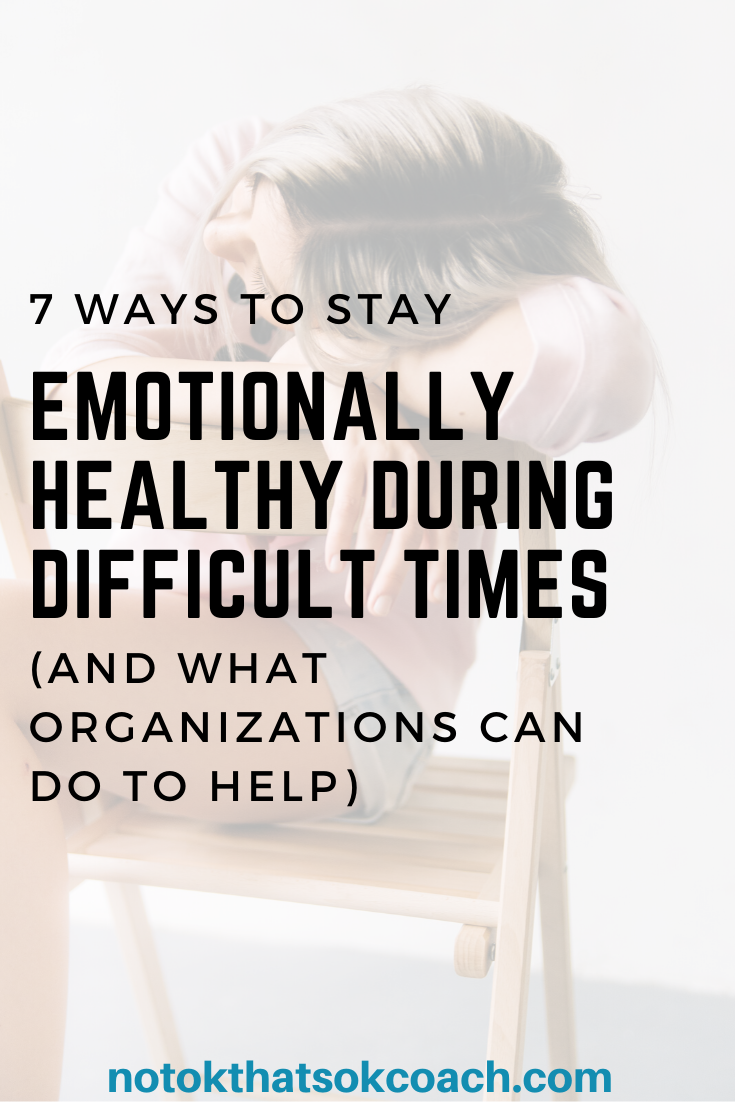As we’re facing very uncertain times it is normal to be anxious and feel unsettled. In fact, humans thrive on routine and familiarity and without it, it is even more difficult to stay emotionally healthy. Right now, many of us are trying to find a new “normal”. Whether that is working from home and hosting conference calls with children in the background, being alone in a one-bedroom apartment, or working endless hours as a medical professional.
This new and uncertain territory is something many of us have never experienced. While there is no road map, there are things that we can do to become more emotionally healthy. There are also ways that organizations and leaders can help ease this transition for their employees and provide them with support during these times
Create routine or structure where you can
As a mom of two kids (7 and 10), creating a new routine has not been easy. Our school district is not yet requiring home school, but in an attempt for my husband and I to both work and for my kids to find some “normalcy,” we have been working on a schedule. It has been a mix of online work, outdoor play, and live virtual classes. The night before we share our scheduled call times with one another in an effort to try to fill in the blanks with self-directed activities. While each day has looked a little different, creating and communicating a game plan with our kids and each other has been helpful.
As a leader, now is the time to communicate expectations in terms of work schedule and provide flexibility when possible. Do employees need to be online from 9-5 or is it more about getting projects done by a specific deadline? How often will one-on-one or team meetings take place? Will they be audio, video or a combination of both? The more guidance you are able to provide, the “easier” it is for employees to create a more sustainable plan and be prepared.

Find a virtual community
As a non-elementary educator, I did not know where to start in creating an educational schedule for my kids. I joined a Facebook group, that has provided a lot of resources, hosts live book readings and brings some humor to the situation. As an entrepreneur who already worked from home, I had an established virtual community with people who were going through very similar things. I have been reaching out and using this network as a sounding board.
Virtual communities are also a great way for employees to continue to build relationships with their colleagues. Going from seeing people for 40 hours a week to not knowing the next time you’ll be back in the office can leave a little social void. You can achieve this through a Slack channel or a video communication platform. Think of this as a place to discuss things happening outside of work (shows you’re binge watching, board games you’re playing, or new book finds) and get in some virtual water cooler conversation.
Practice self-care
Self-care looks different for everyone and is definitely not as easy when you are not leaving the house. While for some it might be going on a brisk run, for others it’s reading a good book. Especially when we are home (potentially with other people), taking some time for yourself to unwind is more important than ever. If you’re used to time to yourself on your commute to vent or just detox after a long day, finding small pockets of time is key. For now, I have been taking a brief solo run or bike ride to clear my mind when I can or having dance parties with my favorite music (90’s hip hop in case you were wondering).
If your organization offers any discounts for virtual memberships, now is the time to remind employees about them. And if this is something you haven’t offered in the past, consider paying for memberships or providing discounts for virtual workouts, meditation apps, digital bookstores, or even streaming services.
Create a list of things you’ve been wanting to do and did not have time for
I rearranged my spice rack and took down curtains I have disliked since we moved seven years ago. Yes, on day four of being home I cleaned out my spices (some from 2016) and finally took the two minutes to take down curtains. No, I didn’t redo a bathroom, write a symphony or anything novel as of yet, but I accomplished two things that I have been pushing off for years. There was always something more important (sometimes catching up on a show) that prevented me from getting started. I was also a little backlogged on sending thank you notes to clients and was able to send virtual cards.
As a leader, now can be a time to ask your employees what professional development opportunities they have been wanting to pursue. If there is space for them to pursue it, review virtual options (webinars, courses, virtual conferences). If now is not the time for them to start because of more pressing work, create a plan for when things settle down.
Disconnect from social media
Like many other people, I have been finding myself reading endless posts, articles, and statistics on the situation as it unfolds. Sometimes this leaves me even more confused, frustrated or mentally exhausted. While using social media can be a great way to connect with friends and loved ones, excessive use can play a toll on mental health. I was having a hard time actually disconnecting and started setting a daily limit on certain applications on my phone. When my time is up, the app lets me know and I cannot use it for the rest of the day.
If your team enjoys challenges, healthy competition, or a chance to communicate, you can suggest a virtual book club, a workout challenges, or anything else that might get them excited. Try to provide alternatives to social media to pass the time.
Reach out to a friend or family member
While some people may be home with family, others might live alone. Now is a great time to call, text, email, and Facetime people in your network. Check in with them to see how they’re doing and take time to laugh and appreciate each other’s virtual company. My husband and I are in the process of putting together a virtual friend game night with Pictionary in the coming days to take a break from our new “normal” routine and get in some much-needed laughs with friends.
As a leader, schedule one-on-one meetings with your employees and ask what they need from you to accomplish their work during this time. You can also send virtual thank you cards to acknowledge the work they’re doing. If your organization can spring for it, send a small gift certificate for a local grocery to offset costs.
Acknowledge emotions
Along with living in these unknown times, many people have been faced with disappointing news. Whether that be a cancelled family vacation, rescheduled weddings, or not being able to see a sick relative in the hospital or nursing home. Acknowledging these emotions is essential in working through them. According to Psychology Today, “when you numb sadness, you also numb happiness and joy.” Trying to make the best of the situation and finding joy, even in small moments, can be helpful.
If your organization offers Employee Assistance Programs (EAP), especially teletherapy sessions with a covered provider, re-communicate this to your staff. Let them know that they are not alone and there are services to use.
- Cultivating Relationships - July 20, 2021
- Empowering Our People - July 13, 2021
- Finding Purpose - July 6, 2021




